Proper maintenance of your phase contrast microscope guarantees ideal image quality and equipment longevity. Clean lenses with lens paper and ammonia-free solvent, apply immersion oil sparingly, and remove it immediately after use. Regularly inspect phase rings and verify they’re correctly aligned with objectives. Perform weekly alignment checks, monthly optical cleaning, and quarterly system testing. Document all maintenance procedures in a detailed log. The right care routine will transform your microscope’s performance and extend its useful life.
Phase Contrast Equipment: Complete Care and Cleaning Guide
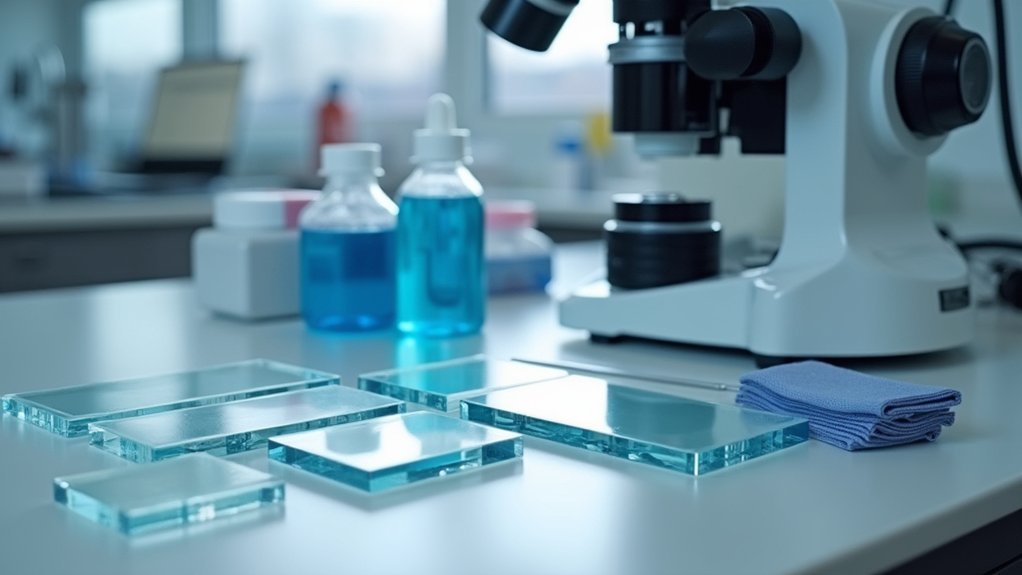
While obtaining striking cellular images through phase contrast microscopy requires technical skill, maintaining your equipment demands equal attention.
Regular maintenance prevents contamination that degrades optical performance and preserves image quality.
Always use appropriate cleaning supplies when caring for your microscope. Clean lenses with lens paper and ammonia-free cleaning solvent, as harsh chemicals can damage delicate optical coatings.
Apply immersion oil sparingly and remove it immediately after use to prevent residue buildup that interferes with components.
Don’t overlook your condenser lens—inspect and clean it routinely to avoid artifacts in your specimens.
Check that the annular aperture and phase plate remain properly aligned, as misalignment greatly reduces contrast.
Understanding Phase Contrast Components and Their Vulnerabilities
Your phase contrast microscope’s functionality hinges on proper phase ring alignment, which requires periodic verification using the Bertrand lens or telescope eyepiece to check for concentric positioning.
When maintaining the condenser turret, you’ll need to guarantee smooth rotation between phase positions and confirm that each annular ring properly aligns with its corresponding phase plate.
Regular inspection and gentle cleaning of these components will prevent image degradation caused by misalignment or debris that commonly affects these vulnerable parts of your optical system.
Phase Ring Alignment
Because proper alignment is the foundation of phase contrast microscopy, your system’s phase rings demand regular attention.
Even slight misalignments between the phase ring and its corresponding objective lens can dramatically reduce image quality and obscure vital details in your specimens.
You’ll need to verify that each phase ring properly aligns with its objective lens markings.
When performing routine checks, confirm the rings are correctly positioned in the condenser turret to facilitate ideal phase-shifting between diffracted and undeviated light.
This alignment is essential to the contrast technique’s effectiveness.
Incorporate phase ring inspection into your regular maintenance protocols for optical instruments.
While cleaning your microscope components, take time to check ring orientation and positioning.
This proactive approach prevents artifacts and maintains consistent performance of your phase contrast microscopy system.
Condenser Turret Maintenance
Three critical components within your phase contrast system require special attention, with the condenser turret being paramount. Regular maintenance guarantees ideal performance and prevents costly repairs. Always check that phase rings align perfectly with your objectives to avoid degraded image quality.
| Maintenance Task | Frequency |
|---|---|
| Alignment check | Weekly |
| Optical components cleaning | Monthly |
| Dust removal | Before each use |
| Component position verification | Monthly |
| System performance testing | Quarterly |
Don’t use plastic dishes under your condenser turret as they depolarize light and compromise contrast. When cleaning optical components, use only approved solutions and lint-free cloths to prevent scratches. Proper turret maintenance directly impacts phase contrast quality—misaligned components can’t produce the phase shift necessary for structural visualization. Regular care extends equipment life while guaranteeing consistently clear images.
Essential Cleaning Supplies for Phase Contrast Microscopes
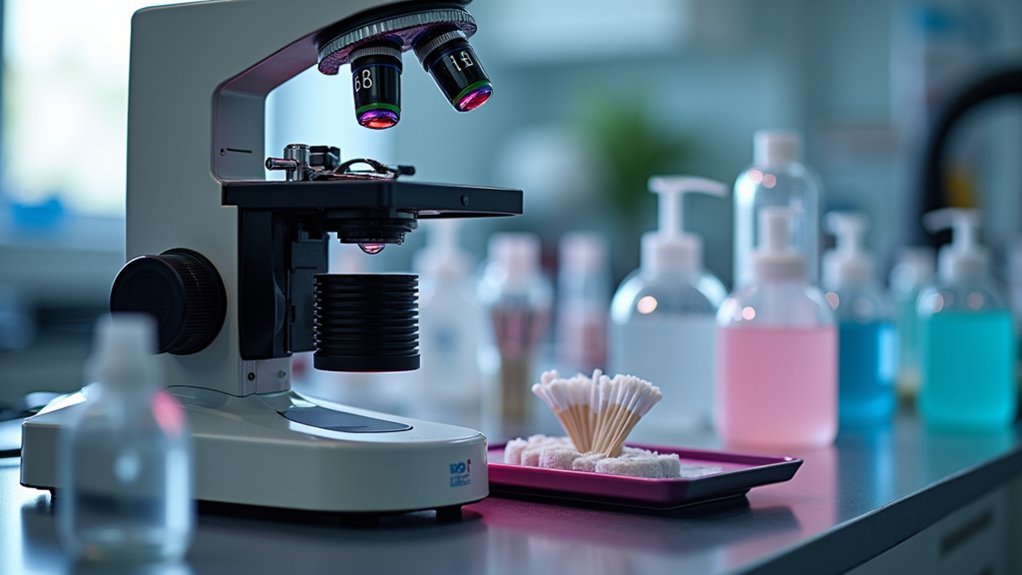
Proper maintenance of phase contrast microscopes requires five specialized cleaning supplies that protect the delicate optical components while ensuring ideal image quality.
Use lens paper and anti-static Kimwipes to gently clean optical surfaces without scratching—critical for maintaining phase contrast microscopy precision.
Delicate optical components demand gentle care—lens paper and anti-static Kimwipes prevent microscopic scratches that compromise phase contrast clarity.
When working with high magnification objectives, apply immersion oil that meets ISO-8036/1 standards with a refractive index of ND=1.515.
Keep a dust blower handy to remove loose debris before applying any solutions. For stubborn contaminants, use only optical lens cleaner specially formulated for delicate surfaces.
Store your cleaning supplies in covered containers to prevent contamination.
These precautions will extend your microscope’s lifespan while consistently delivering the sharp images needed for accurate observations.
Daily Maintenance Routines for Phase Contrast Systems
Maintaining ideal performance of your phase contrast microscope requires consistent daily attention to essential components.
Your daily inspection should focus on preventing dirt buildup that can compromise image quality. Follow these simple yet critical maintenance steps:
- Examine all optical components for dust or residue that might interfere with clarity
- Clean objective lenses with lens paper and appropriate solvents before each use
- Verify that the phase ring aligns correctly with objectives to optimize your phase contrast system
- Check and clean the annular aperture and phase plate to preserve contrast
- When finished, protect your investment by covering the microscope with a dust cover in a clean environment
Remember that cleaning microscope optics properly prevents contamination that can greatly diminish performance and longevity.
Proper Handling and Storage of Phase Rings
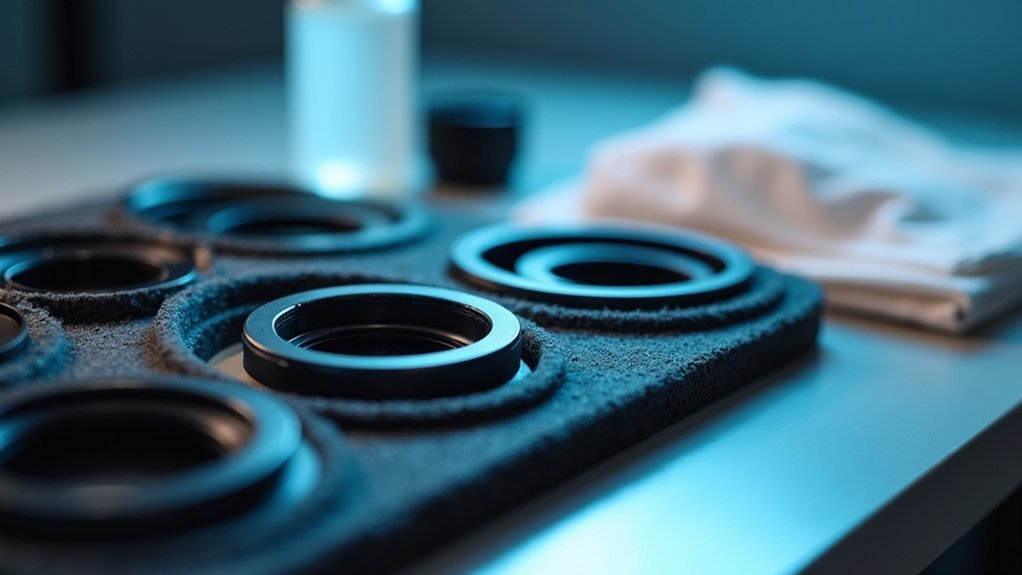
You’ll maintain ideal image quality by always holding phase rings at their edges to prevent contamination on optical surfaces.
Protect your phase rings from dust and physical damage by storing them in their dedicated, clean storage cases when not in use.
Implementing these safe handling procedures and dust-free storage solutions will greatly extend the life and performance of your valuable phase contrast components.
Dust-Free Storage Solutions
Every phase ring in your microscopy kit deserves meticulous protection from environmental contaminants. Creating a dust-free storage system guarantees your phase rings maintain peak image quality and extend their operational lifespan.
- Store rings in sealed containers specifically designed for optical components.
- Always handle rings with clean, dry hands or wear lint-free gloves to prevent oil transfer.
- Use protective caps or covers when rings aren’t in active use.
- Label storage containers with receipt dates and specifications for proper maintenance tracking.
- Regularly inspect stored rings for contamination and clean before use.
Remember to conduct periodic maintenance checks of your storage environment.
Even the most pristine phase rings will deteriorate if kept in dusty conditions. Your attention to these storage details directly impacts the clarity and precision of your microscopy work.
Safe Handling Procedures
Proper handling of phase rings represents the second pillar of effective equipment care. You’ll protect these precision optical components by always handling them by their edges, preventing fingerprints and oils from contaminating optical surfaces.
When not in use, store your phase rings in a dedicated dust-free container to minimize exposure to airborne particles. Before each session, verify that rings are securely seated in the condenser turret with correct alignment to the objective lens.
Regularly inspect your phase rings for dust accumulation. If cleaning becomes necessary, follow manufacturer guidelines for appropriate solvents and cleaning techniques. Never use harsh chemicals that might damage delicate optical properties or protective coatings.
These safe handling practices promote ideal imaging quality and extend the lifespan of your valuable phase contrast equipment.
Cleaning and Aligning the Condenser Assembly
Maintaining the condenser assembly guarantees peak performance and image quality in phase contrast microscopy. Regular care of these critical optical components guarantees your transmitted light path remains clear and properly aligned.
- Check that your condenser turret moves smoothly, reseating it if you encounter any stickiness.
- Verify phase ring alignment between the condenser turret and objectives for ideal contrast.
- Clean condenser lenses regularly to remove dust and contaminants that compromise image clarity.
- Confirm correct placement of all DIC optical components within the condenser assembly.
- Use Koehler alignment with H&E-stained slides for initial focus and proper illumination.
These maintenance steps prevent degradation of image quality and extend the life of your microscope while guaranteeing consistent results in your phase contrast observations.
Objective Lens Care for Optimal Phase Contrast
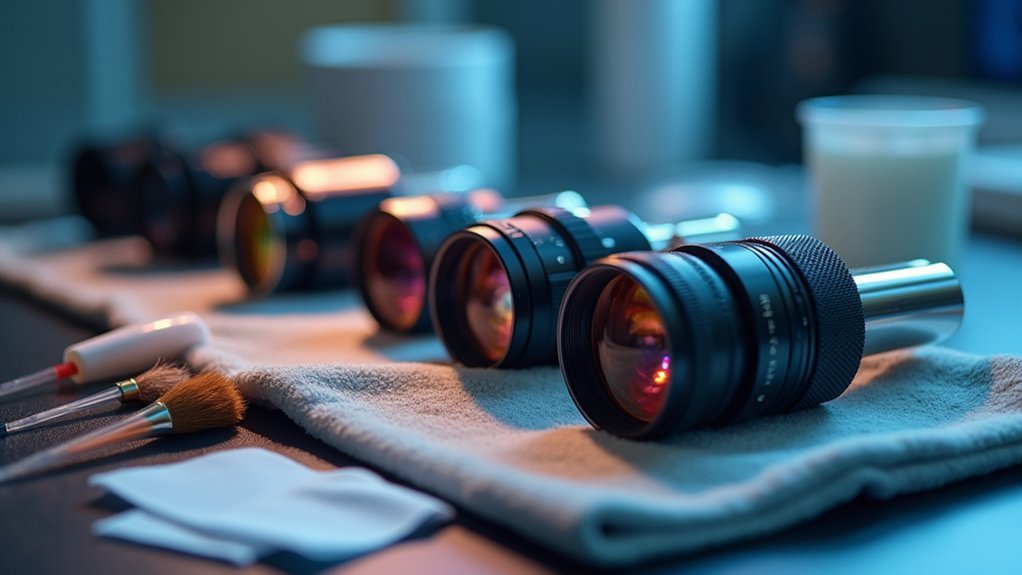
The heart of your phase contrast system lies in its objective lenses, which require meticulous attention to deliver the crisp cellular details and translucent structures you’re seeking.
Regular inspection and cleaning of these lenses prevents artifacts that diminish high image quality. When removing immersion oil, use the “drop and drag” method with appropriate solvents on lens paper.
Don’t leave excess oil on objectives after imaging—this prevents optical problems and mechanical damage. Occasionally unthread your objectives to prevent them from becoming stuck in the nosepiece during long-term use.
Don’t overlook maintenance of hard-coated filters; inspect and clean them every 6–12 months to maintain their effectiveness.
This thorough approach to objective care guarantees your phase contrast microscopy delivers consistently superior results with minimal downtime.
Removing Oil and Contaminants From Phase Contrast Optics
When removing oil from phase contrast optics, you’ll need to compare cleaning solutions for effectiveness and compatibility with your equipment.
You can safely remove contaminants using the “drop and drag” method with lens paper moistened with an appropriate solvent like anhydrous ethanol or isopropyl alcohol.
Always verify solvent compatibility with your specific optical components and inspect surfaces for abrasive particles before cleaning to prevent scratching.
Cleaning Solutions Comparison
Proper selection of cleaning solutions greatly impacts the longevity and performance of phase contrast optics.
When tackling the removal of immersion oil, you’ll need different solutions depending on the contaminant type:
- Distilled water works effectively for water-soluble substances without damaging delicate optical surfaces.
- Ammonia-free optical cleaning solutions specifically formulated for microscopy protect sensitive coatings.
- Organic solvents like anhydrous ethanol or isopropyl alcohol remove stubborn oil residues.
- Manufacturer-approved lens cleaners guarantee compatibility of solvents with your specific equipment.
- Commercial lens cleaning kits often include safe solutions for phase contrast microscopy components.
Remember to perform regular inspection of your optics after cleaning.
The “drop and drag” method with minimal solution prevents recontamination and guarantees quick evaporation, maintaining ideal image quality.
Safe Removal Techniques
Removing contaminants and oil from phase contrast microscopes requires specific techniques beyond selecting the right cleaning solutions. You’ll need to master safe removal methods to protect your valuable optics.
| Technique | Application |
|---|---|
| Lens tissue only | For immersion oil removal to prevent coating damage |
| “Drop and drag” method | Small solvent amount on lens paper for optical surfaces |
| Spiral motion cleaning | Center-to-rim movement prevents scratching |
| High-purity cotton swabs | Remove particulates before applying cleaning solvents |
| Manufacturer consultation | Always check guidelines for phase contrast optics |
After each specimen study, completely remove immersion oil using appropriate techniques. Inspect surfaces under magnification before cleaning to identify contaminants. Remember that phase contrast optics have delicate coatings that require special care. Quick-evaporating solvents help prevent residue formation, ensuring your equipment remains pristine and functional.
Troubleshooting Common Phase Contrast Image Issues
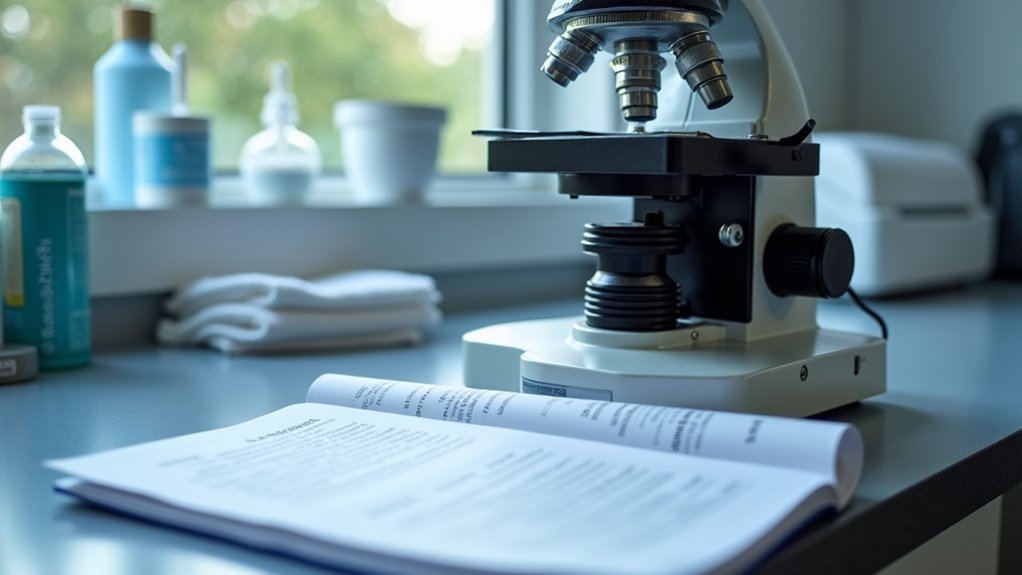
Why do phase contrast images sometimes fall short of expectations?
Even with proper care, you’ll occasionally encounter challenges that affect image quality. Regular inspection and troubleshooting can help identify and resolve these issues efficiently.
- Poor image contrast often stems from misaligned phase rings or dirty optical components, requiring thorough lens cleaning.
- Halo artifacts or fringes appear when your condenser isn’t properly focused or when the annular aperture is obstructed.
- Uneven illumination typically indicates dust buildup or light path misalignment, necessitating careful cleaning of all optics.
- Dim or detail-lacking images suggest incorrect installation of phase contrast components or improper condenser settings.
- Inconsistent performance can be identified through regular evaluation with test specimens, helping pinpoint specific optical issues.
Environmental Considerations for Phase Contrast Equipment
While advanced optical systems deliver stunning cellular detail, your phase contrast microscope requires specific environmental conditions to maintain peak performance.
Store equipment in clean, dry areas away from airborne particles that compromise optical clarity. Keep phase contrast microscopes far from acidic or alkaline chemicals whose vapors can deteriorate sensitive mechanical components.
Protect your optical investment by storing microscopes in pristine, chemical-free environments to preserve component integrity.
Monitor humidity levels carefully, especially in tropical regions where excess moisture promotes fungal growth on optical surfaces. Conduct regular inspections of your microscope’s surroundings to identify potential vibration sources that may affect image quality.
Never use cleaning fluid near an uncovered microscope.
When not in use, shield your investment with protective covers or plastic bags to prevent environmental contaminants from settling on critical components, extending your instrument’s lifespan and maintaining its precision.
Preventative Maintenance Schedule for Long-Term Performance
Beyond environmental safeguards, a structured maintenance schedule greatly extends your phase contrast microscope’s lifespan.
Implementing preventative maintenance routines protects your investment and maintains ideal image quality.
- Perform monthly inspections of optical surfaces and mechanical components to catch potential issues early.
- Clean immersion objectives thoroughly after each use, following proper oil application techniques.
- Inspect and clean phase contrast components (annular apertures and phase plates) semi-annually to prevent contamination.
- Monitor environmental conditions consistently—temperature and humidity fluctuations can promote fungal growth.
- Maintain a detailed maintenance log documenting all cleanings, inspections, and repairs.
This systematic approach helps you avoid performance degradation and guarantees reliable results.
When optical elements remain clean and precisely aligned, your microscope will deliver consistent, high-quality images for years to come.
Documentation and Record-Keeping for Equipment Care
Meticulous documentation serves as the backbone of effective microscope maintenance, providing critical historical context for your equipment. Establish a thorough log for each microscope that tracks all cleaning procedures, routine inspections, and repairs performed.
Record dates, specific issues encountered, and their resolutions to identify potential recurring problems. Document which cleaning supplies work best with your phase contrast equipment, noting any solvents to avoid. This practice establishes consistent care guidelines for all users.
Create digital backups of important software configurations to quickly restore peak microscope performance if settings are accidentally changed. Review and update your documentation regularly to reflect procedural changes and equipment modifications.
Make these records accessible to all users, ensuring everyone follows the same maintenance standards for prolonged microscope life and reliability.
Professional Service Guidelines: When to Call the Experts
Even with thorough documentation and regular care, your phase contrast microscope will occasionally require professional attention.
Recognizing when to seek professional assistance is essential for maintaining ideal instrument performance and preventing costly damage.
Knowing when to call in the experts safeguards your instrument investment and ensures optimal performance for years to come.
- When image quality issues persist despite routine maintenance and proper lens cleaning
- If mechanical components become stuck or show signs of corrosion that you can’t resolve
- When contamination issues remain after following standard cleaning protocols for immersion oil residue
- If optical problems require complex disassembly for thorough cleaning of internal components
- When vibration or environmental factors affect microscope performance despite your best efforts
Remember that attempting advanced repairs yourself can worsen problems.
Professional technicians possess specialized tools and expertise to address sophisticated optical and mechanical issues that extend beyond regular maintenance procedures.
Frequently Asked Questions
How Do You Prepare for a Phase Contrast Slide?
You’ll select a clean slide, add immersion oil, place a thin specimen, cover with a slip, and align the phase ring with your objective lens for ideal imaging of unstained structures.
What Are the Proper Care, Cleaning, and Maintenance Procedures for Microscopes?
Regularly clean your microscope in a dust-free environment. Wipe lenses with lens paper and non-ammonia cleaners. Remove immersion oil immediately after use. Don’t use pressurized air. Maintain a detailed cleaning log and conduct routine inspections.
How Often Should a Microscope Be Cleaned?
You should clean your microscope after each use, especially when using oil or biological samples. Check objective lenses regularly, inspect soft-coated filters every 2 months and hard-coated ones every 6-12 months.
Why Should the Oil Immersion Objective Be Cleaned Immediately?
You should clean the oil immersion objective immediately because leftover oil can degrade optical performance, damage lens coatings, penetrate mechanical components, and harden over time, making future cleaning more difficult and potentially costly.
In Summary
You’ll extend your phase contrast equipment’s life by following these care guidelines consistently. Remember, proper cleaning and maintenance aren’t optional luxuries—they’re essential investments that protect your valuable microscope system. Document all maintenance activities, know when to seek professional help, and you’ll avoid costly repairs while ensuring reliable performance. Your diligence today guarantees accurate observations tomorrow.

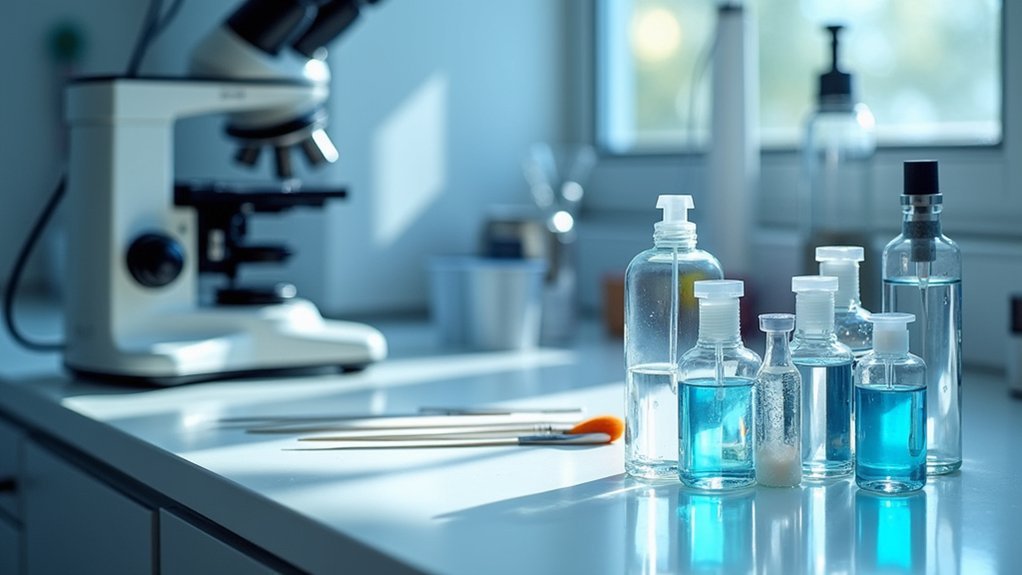



Leave a Reply